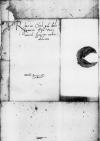List #2970
Bona Sforza do Ioannes DANTISCUSCracow (Kraków), 1546-06-04
| odebrano Heilsberg (Lidzbark Warmiński), 1546-06-25 Rękopiśmienne podstawy źródłowe:
| ||||
Tekst + aparat krytyczny + komentarz Zwykły tekst Tekst + komentarz Tekst + aparat krytyczny
Reverendissimo in Christo Patri, domino
Reverendissime in Christo Pater, sincere nobis dilecte.
Egimus non gravatim cum
Bene valeat Paternitas Vestra.
Ex commissione propria sacrae reginalis maiestatis


 BCz, 3465, p. 324
BCz, 3465, p. 324